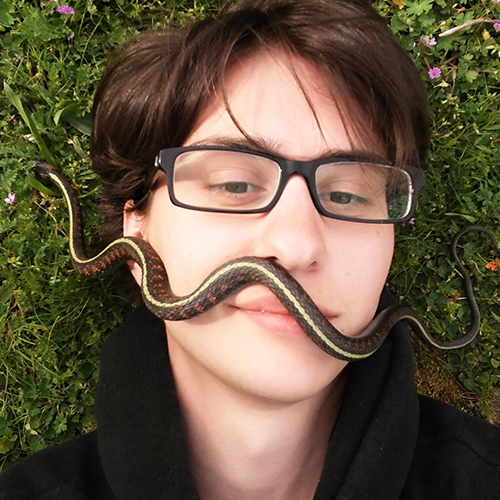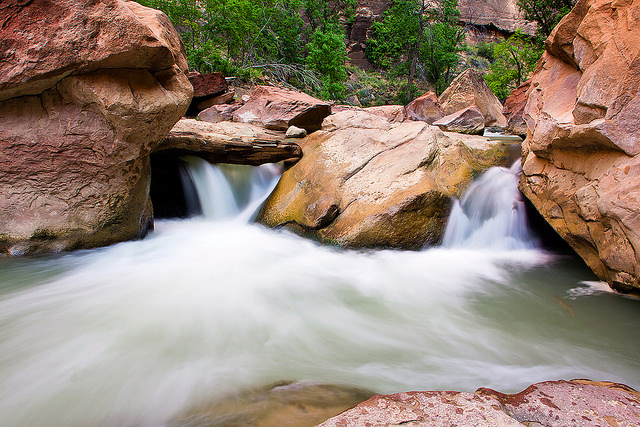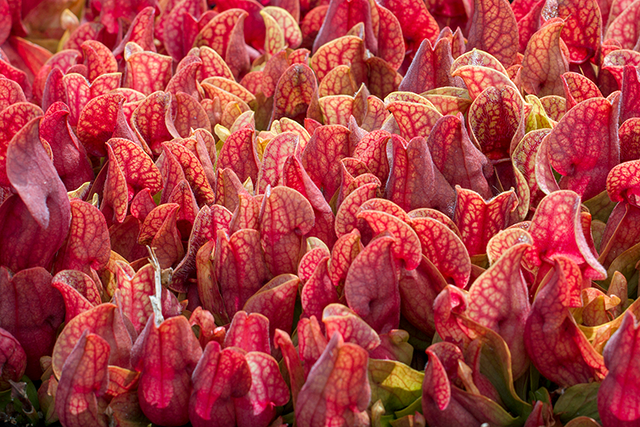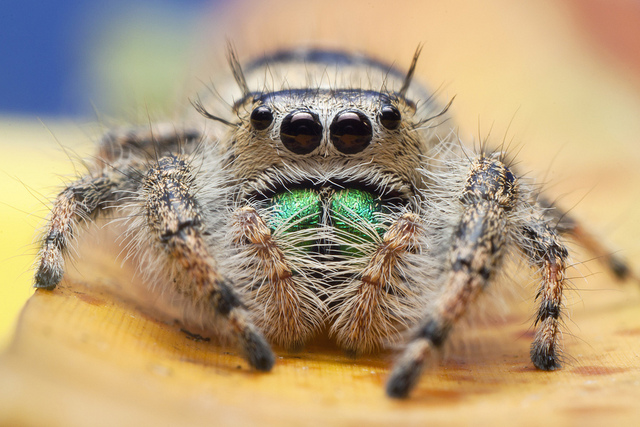 When I was 14 years old, my family got our first computer and the internet. As a very antisocial kid who lived in the country away outside of any town limits, the internet caused my social life to bloom. More than 15 years later, some of those people I met in the beginning days of my online life are still with me. Including my best friend Lee Jaszlics, who has been stuck with me since that first giant desktop Dell computer. We met on an art forum – they were in Colorado and I was in Wisconsin – and we’ve been in each other’s lives ever since. We even ended up going to the same college for a short time, living in the same city, and they stood up for me at my wedding. That’s an internet friendship that’ll go down in the history books.
When I was 14 years old, my family got our first computer and the internet. As a very antisocial kid who lived in the country away outside of any town limits, the internet caused my social life to bloom. More than 15 years later, some of those people I met in the beginning days of my online life are still with me. Including my best friend Lee Jaszlics, who has been stuck with me since that first giant desktop Dell computer. We met on an art forum – they were in Colorado and I was in Wisconsin – and we’ve been in each other’s lives ever since. We even ended up going to the same college for a short time, living in the same city, and they stood up for me at my wedding. That’s an internet friendship that’ll go down in the history books.
Over the years, Lee has grown more amazing and more talented than ever and I’m so proud to show off their incredible photography for everyone. If you follow me on twitter than you’ve probably seen me promote their photography a lot. It’s for a good reason. Lee is a constant source of inspiration to me which is why I asked them to do this interview with me.
So without further ado, I’ll let Lee do the talking.

01. Boring intro question! Tell us about yourself and how you got into photography in the first place?
I got into photography purely as an accident – I actually bought my first camera to collect research data as an undergraduate, and after I’d finished digitizing several hundred photos of crocodile skulls, I decided to keep the camera, and started shooting on class field trips and around my campus, and I discovered that I loved it.
My first attempts were very, very bad, of course, but I was able to connect with the insect photography community quite early on. I attended the very first BugShot workshop, and that really opened my eyes to a lot of the tools of the trade: how to work with light, think about composition, and even how to put yourself into the right mental frame to take photos of wild creatures.
I’ve sort-of been slinking away from macro and insects over the last few years, but the frame of mind that I took from that – thinking about environment, and light, and how to showcase things from unique and perspectives, has stayed with me through the years.

02. You take pictures of a lot of subjects – spiders, reptiles, birds, landscapes, etc. What are you favorite things to photograph, and, probably related, what are the hardest things to photograph?
I don’t know that I necessarily have a favorite species to photograph, but I do like to focus on capturing personality and mood. Jumping spiders are great subjects; they love to cock their heads and admire their reflections in my lens. I’m also very fond of shorebirds, who are often shy and reserved, so getting a good photo is always a challenge. And I love snakes and monitor lizards – it’s probably the forked tongue.
I actually find that the hardest things for me to photograph are landscapes. I have very strong emotional reactions to places, but, for me, at least, a lot of that is tied up in unphotographable things – temperatures, smells and textures (I have a horrible habit of touching every plant I pass) – and communicating those feelings through color and light is quite challenging for me. I also find landscape compositions much trickier than compositions that are centered on animals.

03. What do your photographic process look like, from start to finish?
I’ll usually start by location scouting. Sometimes I have a good idea of a particular species that I want to capture so I’ll try to find places where it’s been seen. eBird is a really good tool for this. For things that aren’t birds, I usually go through geotagged photos or talk to people who might have some ideas. If I’m not after a particular animal, I’ll aim for parks and wilderness areas, and try to get an idea of what they look like and what the local biodiversity is like so that I know how to prepare for the things I’m likely to find.
Once I have a good area in mind, I’ll usually hit it relatively early. Morning light is good for landscapes and birds, and as the day heats up, I’ll switch over to insects and invertebrates. I do occasionally photograph in the evening or at night, but only if I’m specifically looking for reptiles or want to take sunset photos. But I usually find that working in the morning lets me stretch out my day and get wrapped up in what I’m doing without worrying about running out of daylight, which is nice. I’ll usually have some ideas of the shots I want, so I’ll try to get those done, and while I’m working, I’ll take a lot of photos of things that strike me while I’m working. I hike at a snail’s pace, because I tend to stop every three feet to take a photo. Most of these never see the light of day, but they get me into the right frame of mind to appreciate and focus on everything around me.
After I’m done, I process my photos. Almost everything is done in Adobe Lightroom, but I will break out Photoshop for things that are particularly knotty. While I’ve worked hard to be able to take a good photo straight out of the camera, I think that the ability to process photos well is very important, and just another tool for photographers. I’m not aiming to show you what my camera sensor saw, but to capture the feeling of a place or an organism and what it was like for me in that moment. (At the same time, I do think it’s important for me to disclose when I’ve done anything really egregious in my photo process, like compositing images or photographs of captive animals instead of wild ones.)

04. If you could photograph anything or anyone from history that’s not around anymore, what/who would it be?
New Zealand pre-human colonization, definitely. I love New Zealand, and it’s one of the most beautiful places I’ve ever visited, but I think it’d be even better with moas and giant eagles. I mean, everything’s better with giant eagles, right?
05. You travel A LOT – where is your favorite place to take photos and what is your favorite photography memory?
Well, if I have the choice to go anywhere in the world, I’ll always go to Australia. Far North Queensland is probably my favorite region of the country – but ask me again if I ever have the chance to visit Western Australia – the bird life in the rainforest there is incredible, and there are these wonderful giant stick insects that smell like peppermint when you pick them up!
My favorite photographic memory is from there, actually – I was on the road to Cape Trib from Port Douglas when I saw a young cassowary crossing the road. Obviously, I had to pull out and get a photo, and while I was doing this, the young bird got curious, watching me, and coming closer to investigate. I don’t know if you know anything about cassowaries, but they’re huge and they’ve got this massive, dinosaurian claw on one toe! I was a little nervous, especially because cassowaries are raised by their dads, and I though this one might be young enough to still have a full grown, overly protective parent nearby. So, there I was, pressed up against my rental car, trying to give this bird the space and respect he deserved, and trying to get pictures at the same time!
I got the photo, and wasn’t disemboweled by an angry cassowary, so it was a pretty good day.

06. You are, by trade, a digital photographer. What are your thoughts on traditional film photography?
Well, for what I do, let me just say that I am so, so glad that the digital camera exists! I take a lot of shots, especially when I’m trying to catch an insect that’s scuttling around, or a bird in flight, and if I had to pay for film, I’d be really, really broke. I don’t actually understand how people took wildlife photos before the advent of digital cameras, but I admire them immensely – clearly they were far more patient people than me. Plus, the immediate feedback of digital is really nice – taking a photo and then immediately being able to check to make sue your exposure is good and your composition looks nice is hugely helpful.
But film photography is an important art form, and the skillset that goes into it is vast and impressive, and there are a lot of things to recommend film as a medium – you can often get better noise performance and better colors! Plus you have a full-frame sensor for relatively cheap! Sometimes, I’m a little jealous. At the end of the day, as long as you get the photos that you want, the tool that you used is unimportant. (But knowing how to use the tools that you have? That’s critical.)

07. AND FINALLY! You take tons of SUPER colorful photos – but what’s your FAVORITE color and does it photograph well?
I love oranges and greens, and they’re both awful colors to photograph. Oranges tend to the gaudy and artificial, while greens tend to turn weird and yellowy. I fight a constant battle with my camera calibration and color balance. One of these days, I might even win.

You can find Lee & their photography elsewhere on the web:
SnakePhotographer.com
SmugMug Print Shop
Timelapse Gallery
Flickr Gallery
Twitter